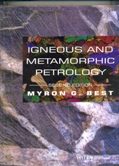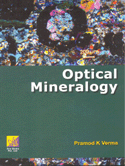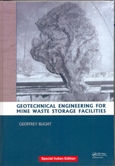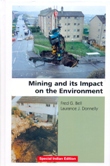
|
IGNEOUS AND METAMORPHIC PETROLOGY 2ND ED - MYRON G. BEST (EX) |
|
|
Cover Price : Rs 3,495.00
|
Imprint : Blackwell / Ane Books
ISBN : 9788126540617
YOP : 2013
|
Binding : Hardbound
Total Pages : 752
CD : No
|
|
Igneous and metamorphic petrology has over the last twenty years expanded rapidly into a broad, multifaceted and increasingly quantitative science. Advances in geochemistry, geochronology, and geophysics, as well as the appearance of new analytical tools, have all contributed to new ways of thinking about the origin and evolution of magmas, and the processes driving metamorphism.
This book is designed to give students a balanced and comprehensive coverage of these new advances, as well as a firm grounding in the classical aspects of igneous and metamorphic petrology. The emphasis throughout is on the processes controlling petrogenesis, but care is taken to present the important descriptive information so crucial to interpretation.
Contents
Preface.
1. Overview of fundamental concepts.
2. Composition and classification of magmatic rocks.
3. Thermodynamics and kinetics: an introduction.
4. Silicate melts and volatile fluids in magma systems.
5. Crystal-melt equilibria in magmatic systems.
6. Chemical dynamics of melts and crystals.
7. Kinetic paths and fabric of magmatic rocks.
8. Physical and thermal dynamics of bodies of magma.
9. Magma ascent and emplacement: field relations of intrusions.
10. Magma extrusion: field relations of volcanic rock bodies.
11. Generation of magma.
12. Differentiation of magmas.
13. Magmatic petrotectonic associations.
14. Metamorphic rocks and metamorphism: an overview.
15. Petrography of metamorphic rocks: fabric, composition, and classification.
16. Metamorphic mineral reactions and equilibria.
17. Evolution of imposed metamorphic fabrics: processes and kinetics.
18. Metamorphism at convergent plate margins: P-T-t paths, facies, and zones.
19. Precambrian rock associations.
Appendix A.
Appendix B.
References Cited.
Glossary.
Index
Myron G. Best is Professor Emeritus at Brigham Young University, is a Fellow of the Geological Society of America, and a member of the American Geophysical Union.
|
|
 |

|
Optical Mineralogy - Pramod K. Verma |
|
|
Cover Price : Rs 1,995.00
|
Imprint : Ane Books Pvt. Ltd.
ISBN : 9789380156088
YOP : 2014
|
Binding : Hardbound
Total Pages : 381
CD : No
|
|
|
About the Book
Designed to be useful even after students have completed thier formal optical mineralogy course, Optical Mineralogy covers advances in instrumentation and includes illustrations of minerals as seen through petrological microscopes. The initial chapters familiarize readers with essential concepts in optics and optical mineralogy and questions at the end of each chapter provide insight into issues students will find in the field. With tables that make important informations easily accessible, the book highlights the importance of optical mineralogy in the eliciting of information about the interior of crystals.
Contents
Preface, Part I : Principles and Techniques of Optical Mineralogy, 1.Properties of Light, 2. Sample Preparation for Transmitted Microscopy, 3. Refractometry, 4. Optical Crystallography, 5. The Polarizing Microscope, 6. Microscopic Examination of Minerals I: Orthoscopic Condition, 7. Microscopic Examination of Minerals II, 8. Microscopic Examination of Minerals III: Conoscopic Condition, 9. Reorienting Techniques, 10. New Frontiers in Microscopy, Part II : Systematic Description of Common Rock Forming Minerals, 11. Nesosilicates, 12. Sorosilicates and Cyclosilicates, 13. Inosilicates, 14. Phyllosilicates, 15. Tektosilicates, 16. Non-silicates, Appendices, Michael Levy Chart
About the Author
Pramod Kumar Verma, a professor of Geology at the University of Delhi, received his Ph.D. in Geology from Harvard University, U.S.A. in 1973. Dr. Verma has taught undergraduate and graduate level courses in mineralogy and physical geochemistry during last four decades. He is primarily a metamorphic petrologist, but began his research in the regional geology of metamorphic rocks in the Eastern Himalayas. In addition to the Himalayas, his current interest is in the petrology of planetary interior. He has published several research articles in leading international journals, and edited two books on the Eastern Himalayan Geology. Prof. Verma has held visiting assignments in the USA, Germany and Zambia. He is a Fellow of the Mineralogical Society London. He has served as President of the Earth System Sciences Section of the Indian Science Congress and Vice President of the Indian Geological Congress. |
|
 |

|
Geotechnical Engineering for Mine Waste Storage Facilities - Geoffrey Blight |
|
|
Cover Price : Rs 5,995.00
|
Imprint : CRC Press
ISBN : 9780415468282
YOP : 2015
|
Binding : Hardbound
Total Pages : 654
CD : No
|
|
The book is a comprehensive treatment of the application of geotechnical engineering to site selection, site exploration, design, operation and closure of mine waste storage facilities.
It has been developed from the official mining industry guide to the design and operation of tailings and waste rock storage facilities in South Africa, and also from a series of post graduate courses that have been taught at the University of the Witwatersrand, Johannesburg for many years. The level and content are suitable as a technical source and reference for practising engineers engaged both in the design and operational management of mine waste storage facilities and for senior undergraduate and postgraduate students.
The thirteen chapters follow the sequence of the life cycle of a waste storage facility and also consider the use of mine waste as a construction material. The text is liberally illustrated by both line drawings and photographs, and the theoretical passages are supported by typical test results, worked examples and carefully analysed case histories.
Contents
Chapter 1: Waste Engineering, Characteristics of Mine Wastes and Types of Waste Storage
The nature and magnitude of the mine waste storage activity
Origins and quantities of mine waste
The effects of climate
Waste characteristics
Principles of mine waste management
Types of mine waste storage
Philosophy and arrangement of this book
Chapter 2: Selection of a Site for Storage of Mine Waste
Procedure for site selection
Preliminary assessment of required size of site
Possible fatal flaws in candidate sites
Seeking and obtaining public acceptance
Preliminary ranking of candidate sites
Site feasibility study
Risk analysis
Environmental impact report
Preliminary geotechnical characterization of waste
Preliminary site investigation
Final site selection
Examples of disastrous selection of sites
Chapter 3: Geotechnical Exploration of Sites for Development of Mine Waste Storages
Soil engineering survey
Soil engineering data
Detailed information for design of slopes & seepage control
Profile description
Simple in situ tests and soil sampling
Taking undisturbed soil samples for laboratory testing
Chapter 4: Environmental and Engineering Characteristics of Mine Waste, Including Stress and Strain Analysis and Laboratory Shear Testing
Characteristics having environmental impact
Engineering characteristics
Changes of waste characteristics with time, and other considerations
Analysis of stresses and strains and the principle of effective stress
The behaviour of mine waste materials subjected to shear
The process of consolidation and pore pressure re-distribution in laboratory shear tests
The strength and viscosity of tailings at large water contents
The shear strengths of interfaces
The shear strength of waste rock
Strain softening of "dry coarse mine wastes
The mechanics of unsaturated waste materials
Chapter 5: In Situ Shear Strength Testing of Tailings and Other Waste Materials and Test Interpretation
The shear vane test
The pressuremeter test
The cone penetrometer test
Estimation of potential for liquefaction from cone penetration tests
Chapter 6: Measuring the Coefficient of Permeability in the Laboratory and In Situ, Seepage Flow Nets, Drains and Linings, Geosynthetics, Geomembranes and GCLs
Measuring permeability
Observed differences between small scale and large scale permeability measurements
Laboratory tests for permeability
Methods for measuring permeability in situ
Estimation of permeability from field tests
Large-scale permeability tests using test pads
The permeability of tailings
Seepage and flow nets
The design of filter drains
Calculation of seepage rates through tailings storages
The processes of consolidation and pore pressure re-distribution
Basal impervious liners and surface cover layers
Blockage of filter drains and geotextiles
Geosynthetic materials
Chapter 7: The Mechanics of Compaction
The compaction process
Uses of compaction in mine waste engineering
The mechanisms of compaction
Relationships between saturated permeability to water flow and water content
Laboratory compaction
Precautions to be taken with laboratory compaction
Compaction in the field
Designing a compacted clay layer for permeability
Seepage through field-compacted layers
Control of compaction in the field
Special considerations for work in climates with large rates of evaporation
Additional points for consideration
Chapter 8: Methods for Constructing Impounding Dykes for Storing Hydraulically Transported Tailings and Other Fine-Grained Wastes
Deposition methods and sequences
Beach formation in hydraulic deposition of fine-grained wastes
Predicting beach profiles
Details of particle size sorting during hydraulic deposition
Effects of particle size sorting on permeability, water content and strength variation down a beach
A comparison of tailings beaches formed in air and in water
Methods for depositing slurries of tailings and other fine-grained waste materials
Operational systems for tailings storages
An example of building an embankment by underwater deposition
Pool control and decanting
Chapter 9: Water Control and Functional and Safety Monitoring for Hydraulic Fill Tailings Storages and Dry Dumps Safety Appraisal Special Considerations for Carbonaceous and Radioactive Wastes
Basis of a water control system
Penstocks or decant towers and spillways
Monitoring systems for waste storages
Appraisal of safety for waste storages
Special considerations for carbonaceous wastes
A note on characteristics of radioactive wastes
Chapter 10: Water Balances for Tailings Storage Facilities and Dry Waste Dumps
Water balances in general
Required data
Components of the water balance for an operational tailings storage
Examples of water balances for operating hydraulic fill tailings storage impoundments
The possibilities for saving water
Seepage from the tailings storage into the foundation strata and the recession of the phreatic surface following cessation of operations
Drainage of interstitial water as the phreatic surface recedes
The water balance for a "dry dump or a closed and rehabilitated tailings storage
Measuring potential infiltration and runoff
Estimating evaporation or evapotranspiration
Measuring evaporation by solar energy balance
Depth to which evaporation extends
The effects of slope angle and orientation on solar radiation received by slopes of waste storages
Water balances for "Infiltrate, Store, Evapotranspire (ISE) covers and for impervious cover layers on mine waste storages
The water balance for a dry ash dump
Disposal of industrial waste liquids by evaporation and capillary storage in waste
The role of soil heat G in evaporation of water from a soil
Further points to consider
Principles of the measuring weir
Chapter 11: Failures of Mine Waste Storages
Failures: causes, consequences, characteristics
Failures of hydraulic fill tailings storages caused by seismic events
Flow failures caused by overtopping
Failure caused by increasing pore pressure
Failures caused by excessive rate of rise
Failure caused by poor control of slurry relative density
Post-failure profiles of hydraulic fill tailings storages
Analysis of the motion of flow failures
The effects of failure geometry on insurance rates
Failures of dumps of coarse wastes
Failures caused by collapse of tailings storages into subterranean caverns or underground workings
Failures of impervious linings installed on steep slopes
Methods for analysis of the stability of slopes
Further points regarding the failure of slopes
Chapter 12: Surface Stability of Tailings Storages Slopes Erosion Rates, Slope Geometry and Engineered Erosion Protection
Past practice for slope angles of tailings storages
Acceptable erosion rates for slopes
Wind erosion compared with water erosion
Acceptable slope geometry for tailings storages
Protection of slopes against erosion by geotechnical means
Special considerations applying to badly eroded abandoned or neglected tailings storages
The effect of eroded tailings on the surroundings of a storage of sulphidic tailings
Wind speed profiles, amplification factors and wind erosion
Wind speed profiles over natural and constructed slopes
Wind tunnel tests on model waste storages
Erosion and deposition by wind on full size waste storages
Analysis of particle movement in the wind
Summary of points to be considered
Chapter 13: The Use of Mine Waste for Backfilling of Mining Voids and as a Construction Material
Applications of backfilling
Backfilling of shallow underground mine workings to stabilize the surface
The properties of mine waste as a structural underground support in narrow stopes
Measurements in situ of stresses and strains in fills at great depth
Supporting narrow stopes with steel-reinforced granular tailings backfill
The behaviour of steel mesh-reinforced square columns of cemented cyclone tailings underflow (grout packs)
The use of geotextiles for temporary retention of backfill in narrow stopes during hydraulic placing
The use of mine and industrial wastes in surface construction
Subject Index
|
|
 |

|
Mining and Its Impact on the Environment - Fred G.Bell |
Author |
Fred G. Bell
Laurance J. Donnelly
|
|
Cover Price : Rs 5,495.00
|
Imprint : T & F / Routledge
ISBN : 9780415286442
YOP : 2015
|
Binding : Hardbound
Total Pages : 560
CD : No
|
|
Mining involves the extraction or abstraction of mineral deposits from the Earth and has been practiced by man since palaeolithic times. As such, It has played an important role in the development of civilization. Unfortunately, the working and processing of mineral deposits can give rise to environmental damage, leading to land being disturbed, topography being changed and hydrogeological conditions being affected adversely. Land that has been spoiled by mining activity generally can be rehabilitated but at a cost. This cost may be recovered indirectly by the benefit that a more attractive environment brings to an area so affected.
Mining and its Impact on the Environment provides an overview of the subject, in particular, of the various aspects of subsidence, waste disposal, pollution and dereliction as caused by different types of mining area being remediated. This book will be of benefit to Professionals involved with the development or redevelopment of mining areas, such as civil and mining engineers, engineering geologists, geotechnical engineers, environmental scientists, land developers, hydrologists, hydrogeologists, planners, and students in these fields.
Contents
1. Introduction 2. Subsidence Due to the Partial Extraction of Stratiform Mineral Deposits 3. Longwall Mining and Subsidence 4. Metalliferous Mining and Subsidence 5. Abstraction of Fluids and Subsidence 6. Quarrying and Surface Mining 7. Waste Materials from Mining and Their Disposal 8. Mine Effluents and Acid Mine Drainage 9. Dereliction and Contamination Associated with Mining and Related Industries 10. Other Problems Associated with Mining, Index.
Fred G. Bell is a Research Associate with the British Geological Survey, formerly Professor and Head of Department of Geology and Applied Geology at the University of Natal, Durban, South Africa. He has acted as a consultant and advisor to numerous organizations. He is the author or co-author of some 230 papers and author or editor of 20 books.
Laurance Donnelly is presently a consultant geologist with the Halcrow Group Limited and was previously with International Mining Consultants Limited and the British Geological Survey. He has worked in the UK, Europe, Asia, Australia, Middle East, Central and South America and the Caribbean on mining related projects. He is the author or co-author of some 70 publications.
|
|
 |
|